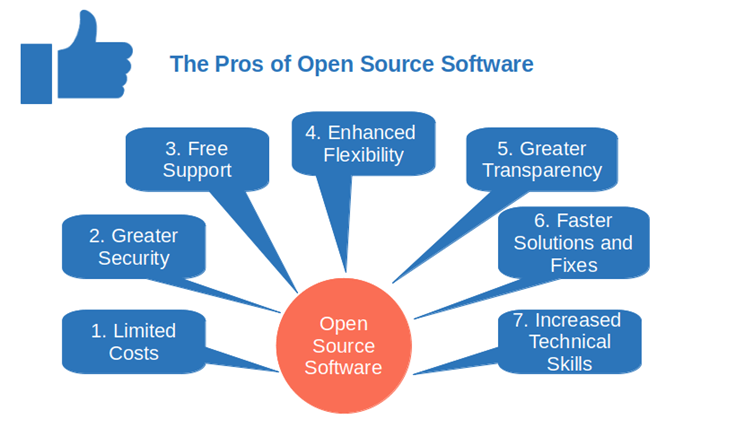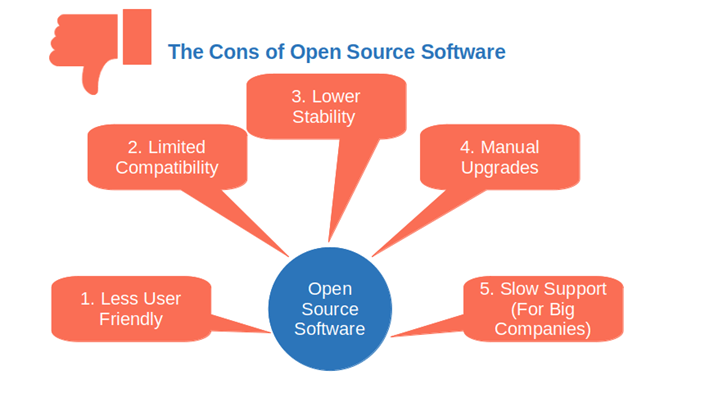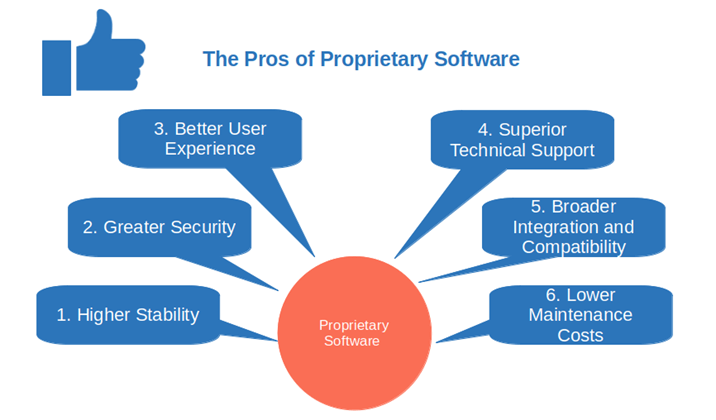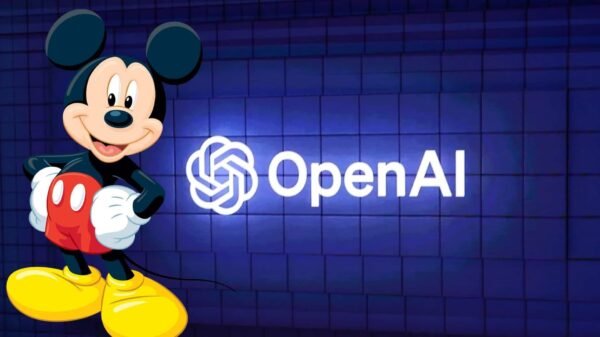- Open-source software is usually free or low-cost compared to proprietary software.
- The open-source community allows for collaboration and contributions from developers and users worldwide.
- Open-source software's transparency can enhance its security and customization.
- Open-source software may lack professional technical support.
- The decentralized development model can lead to potential quality control issues and inconsistent performance.
- The licensing model can create intellectual property challenges for companies.
Definition of open-source software. Brief history and evolution of open-source software
Technology has embraced open-source software. Open-source software is produced, updated, and shared collaboratively. Open-source software is free to use, change, and develop. How did open-source software originate and evolve? We must return to the early days of computers to address that issue. Throughout the 1950s and 1960s, a few huge businesses generated and owned most software. Some firms restricted code access and overcharged. "Proprietary software" was developed this way. New movements formed as computing technology spread. In the late 1970s and early 1980s, a group of programmers collaborated to enhance each other's code. Open source software was distinct from proprietary software. Open-source software pioneer Richard Stallman founded the Free Software Foundation in 1985. Stallman made a set of licenses that developers can use to make their work available to anyone who wants to use it. The open-source movement gained traction in the years that followed. Linus Torvalds, a student from Finland, created the Linux operating system in 1991 and gave it away for free. Linux quickly became one of the most popular operating systems in the world. It is now used to run everything from servers to smartphones. The field of open-source software has flourished since then. There are thousands of open-source projects going on right now, from frameworks for websites to tools for machine learning. From small startups to Fortune 500 corporations, everything increasingly employs open-source software. Still, using open-source software has its pros and cons, just like any other new technology. In the next part, we'll look at some of the advantages of open-source software development.The Pros of Open-Source Software
When it comes to software development, there are a lot of factors to consider. One of the most important is cost. Creating software can be an expensive process, and proprietary software often costs a lot of money. However, open-source software offers a cost-effective alternative that has a number of benefits.
Photo: Code Signing
Cost. How open-source software saves money compared to proprietary software
One of the most obvious advantages of open-source software is that it is frequently free to use. In contrast to proprietary software, open-source software may be downloaded and used for free. To utilize proprietary software, users must purchase licenses or pay subscription fees. This can help organizations that rely on software to operate their operations save a significant amount of money. Companies do not need to invest much on proprietary software. Alternatively, companies may employ open-source software and redirect the savings to other vital initiatives. Yet, there are more advantages to using open-source software than merely saving money. There are also more advantages to using open-source software that make it a viable choice for both developers and consumers. Some well-known open-source software examples (e.g., Linux, Apache, MySQL) One of the most well-known pieces of open-source software is the Linux operating system. Linus Torvalds created Linux in 1991, and it is now one of the world's most popular operating systems. Anything from phones to supercomputers can run Linux. Yet, Linux is simply one of several open-source software projects accessible today. The Apache web server, MySQL database software, and the Firefox web browser are also well-known. These projects were created and are maintained by a group of developers. They collaborate to improve the software. This collaborative approach has resulted in software that is often more stable, trustworthy, and secure than software produced by a single organization. Furthermore, because open-source software code is publicly available, developers can tweak and adapt it to match their own needs. This is especially critical for firms that want their software to do several functions. Companies and developers should utilize open-source software to save money and gain greater freedom. While proprietary software has some advantages, the collaborative and open nature of open-source software development has resulted in a robust ecosystem of software projects that are altering the way technology works.Community Collaboration. How open-source software development benefits from the contributions of a global community of developers and users
The fact that individuals collaborate on open-source software development is one of its distinguishing features. Instead of being created and maintained by a single company or team of developers, open-source projects are created and maintained by a worldwide community of developers and users. This community participation provides a lot of advantages, including more fresh ideas, shorter development cycles, and higher quality. Success stories from open-source communities (e.g., GitHub, Stack Overflow) GitHub and Stack Overflow are two well-known examples of open-source communities. These platforms enable developers to collaborate, exchange information, and contribute to open-source projects. GitHub, in particular, has emerged as a focal point for open-source software development. It gives developers a place to host and share their code, collaborate on projects, and monitor changes. This has enabled developers from all over the world to collaborate on projects, making the development process more varied and accessible to all. Stack Overflow, on the other hand, is a developer-focused question and answer site. It is a helpful resource for anyone working on open-source projects since it allows developers to ask and answer questions regarding software development. Yet, community collaboration benefits more than simply these platforms. Contributions from developers and users all around the world are essential to open-source projects. This collaborative approach shortens the development cycle since issues and errors may be identified and solved more quickly. It also enables for more creativity because people from all over the world add their own viewpoints and experiences to the development process. Moreover, community cooperation can result in better secure and trustworthy software. Problems may be detected and corrected more rapidly with a worldwide community of developers and users contributing to the development process, and the software can be tested in a variety of contexts and use cases. Finally, one of the finest aspects of open-source software development is that it is created by many individuals working together. Open-source projects may innovate faster, produce higher-quality software, and establish a more inclusive development process by using the strength of a worldwide community of developers and consumers. Now, because to sites like GitHub and Stack Overflow, collaborative tools are more accessible than ever before.Transparency and security How open-source software's code availability and transparency can enhance its security
One of the most frequently mentioned benefits of open-source software is its transparency. In contrast to proprietary software, the code for open-source software may be read, altered, and shared by anyone. The availability and openness of this code can have major security benefits. Examples of open-source software security advantages (e.g., OpenSSL) The OpenSSL project is a well-known illustration of the security benefits of open-source software. OpenSSL is an open-source software library that provides encryption and other security services to a wide range of software programs. In 2014, a severe vulnerability in the OpenSSL code was uncovered, which became known as the "Heartbleed bug." This flaw might have provided attackers access to sensitive information such as passwords. Nevertheless, because OpenSSL is open-source software, the issue was soon identified and resolved by developers and users all across the world. The remedy was made public so that businesses may upgrade their software to seal the security issue. This kind of responsiveness and transparency is not unique to the OpenSSL project. Because of the open-source development process, more individuals can look at and evaluate the code, which can assist uncover potential security gaps sooner. Furthermore, because the code is open to use, security experts and developers may examine and test it in a variety of locations and circumstances. This improves the overall security of the product. Furthermore, the availability of open-source software makes it more difficult for bad actors to put backdoors or other security weaknesses to it. It's impossible to determine what code is running on your machine or what it's doing when it's proprietary software. But, with open-source software, the code is visible to everybody, making it far more difficult for someone to add a vulnerability without being noticed. To summarize, the openness and availability of code in open-source software may be extremely beneficial to security. Open-source software can be safer and more dependable than proprietary software when developers and users from all over the world collaborate to uncover and patch flaws. Yet, as demonstrated by OpenSSL, this collaborative approach to software development may have a significant influence on security for both enterprises and people.The Cons of Open-Source Software
While there are many benefits to using open-source software, there are also some negatives to think about. Open-source software's potential lack of access to competent technical help is a major issue for many businesses.
Photo: Code Signing
Lack of Technical Support. How open-source software users may lack access to professional technical support
Those who want to utilize proprietary software typically have access to technical support teams that can assist them with the product's setup, troubleshooting, and maintenance needs. Users of open-source software, however, may be on their own in terms of assistance with any technical issues. This might be problematic for businesses that rely on their software to do essential tasks. In the absence of expert technical assistance, businesses may experience inefficiency due to the time and effort required to resolve issues. These are some examples of problems that might arise from providing technical help (e.g., compatibility with other software, integration with existing systems) There are several potential causes for technical difficulties while working with open-source software. For example, if you're using an older or less popular system, it may be difficult to get your software or hardware to play along with others. Moreover, it may be difficult to find the necessary in-house technical resources to integrate open-source software with existing systems. The absence of helpful instructions or user-friendly interfaces is another possible problem. Because of potential differences in user assistance and documentation, non-technical users may find open-source software more challenging to work with than commercial software. Ultimately, businesses may struggle if open-source software isn't backed by adequate technical assistance. It is important to remember, however, that many communities centered on open-source software maintain active forums and support networks where users may share information and work together to solve problems. Organizations can still acquire the help they need from third-party providers specializing in open-source software, even if they can't rely on expert technical assistance.Quality Control
Open-source software's development model, which relies on a widespread community of contributors, can be problematic since it makes it hard to maintain quality control and may lead to functionality issues. While there are many benefits to enlisting the help of the community, there are also certain risks when it comes to quality control that businesses should be aware of. How open-source software's decentralized development model may lead to a lack of quality control and inconsistent performance. Open-source software is made by a group of programmers from all over the world who don't work together. This is different from the more traditional model of developing proprietary software, in which a small group of programmers work on a single program from the beginning to the end. This lack of central oversight can lead to differences in how code is written and how it is tested, which in turn can lead to bugs and features that aren't finished. Illustrations of Possible Problems with Quality Control (e.g., bugs, incomplete features) Assuring the quality of open-source software, where anybody may contribute, can be challenging because of the possibility of flaws making it into production. There may not be a central way to make sure that any new code added to open-source software has been tested and verified before it is released. If there isn't a central development team to keep an eye on the project plan, it's more likely that features will be added at random, which will hurt the product's overall quality and ease of use. Open-source software may potentially have problems with missing functionalities. Documentation and user support for open-source software can also be patchy, since different community members may answer questions and solve problems in different ways. Due to the fact that open-source software is developed in a decentralized way, it can be hard for businesses to keep a high level of quality control. But remember that many communities that make open-source software also use code reviews and testing systems to make sure their products are good. Also, since the code for open-source software is available to the public, problems can often be found and fixed more quickly than with proprietary software.Intellectual Property Issues
Even though open-source software has many good points, it's important to know that the way it's licensed can cause issues with intellectual property. Most of the time, open-source software is given out with licenses that let users change and share it as they please. But these licenses can make it hard for companies that use open-source software in their products or services to stay out of trouble. How open-source software's licensing model can create intellectual property challenges for companies When it comes to IP, one of the trickiest aspects of open-source software is enforcing compliance with licensing. Because the license says that any changes or derivative works must also be released under the same license, some companies may end up with unintended legal responsibilities when they use open-source software. Failing to get the necessary licenses may result in legal complications and financial losses.
Photo: Code Signing

















































